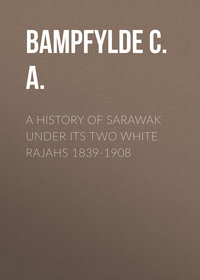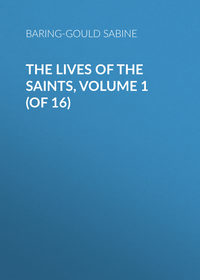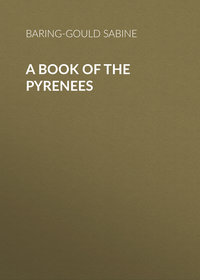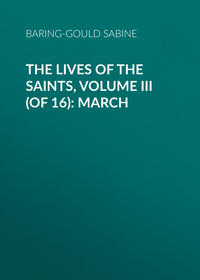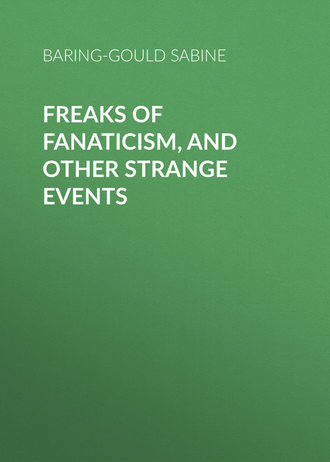 полная версия
полная версияFreaks of Fanaticism, and Other Strange Events
Sleidanus: Commentarium rerum in Orbe gestarum, &c. Argent. 1555; ed. alt. 1559.
I. Hast, Geschichte der Wiederthaüffer von ihren Entstehen in Zwickau bis auf ihren Sturz zu Münster in Westphalen Münster. 1836.
1
Drake was envoy of the British Government at Munich; he and Spencer Smith, Chargé d'Affaires at Würtemberg, were accused by Napoleon of being at the bottom of a counter revolution, and an attempt to obtain his assassination. It was true that Drake and Smith were in correspondence with parties in France with the object of securing Hagenau and Strassburgo and throwing discord among the troops of the Republic, but they never for a moment thought of obtaining the assassination of the First Consul, as far as we can judge from their correspondence that fell into the hands of the French police.
2
Unfortunately the British Museum file is imperfect, and does not contain the Number for August 20th.
3
A. de Beauchamp, Vie de Louis XVIII. Paris, 1824.
4
Antonius Bonfinius: Rer. Hungaricarum Dec., v. 1., 3, gives four reasons. Thomas Cantipratensis, Lib. II., c. 29, gives another and preposterous one, not to be quoted even in Latin.
5
Fleury, Hist. Eccl., vi. p. 110.
6
Le Jubilé d'un faux Miracle (extrait de la Revue de Belgique), Bruxelles 1870.
7
"Cuncti fere cum publicis uxoribus … ducebant vitam." "Et ipsi, ut cernitur, sicut laici, palam uxores ducunt." —Andr. Strum. "Vit. Arialdi." "Quis clericorum non esset uxoratus vel concubinarius?" —Andr. Strum. "Vit. S. Joan. Gualberti."
8
"Cœperunt ipsi presbyteri et diacones laicorum more uxores ducere suscepsosque filios hæredes relinquere. Nonnulli etiam episcoporum verecund â omni contemptâ, cum uxoribus domo simul in unâ habitare." —Victor Papa "in Dialog."
9
"Qui unius mulieris, aut uxoris, aut concubinæ (ut ei placuerit) sit conjunctione contentus." – 1st Conc. of Toledo, can. 17. "Hæ quippe, licet nec uxoribus, nec Reginarum decore et privilegiis gaudebant, erant tamen veræ uxores," say the Bollandist Fathers, and add, that it is a vulgar error "Concubinæ appellationem solis iis tribuere, quæ corporis sui usum uni viro commodant, nullo interim legitimo nexu devinctæ." – Acta SS., Jun. T. L. p. 178.
10
It is the same with St. Gregory, Nyssen, Baronius, Alban, Butler, and other modern Hagiographers make this assertion boldly, but there is not a shadow of evidence, in any ancient authorities for his life, that this was the case.
11
"Hic Archiepiscopus habuit uxorem nobilem mulierem; quæ donavit dotem suam monasterii S. Dionysii, quæ usque hodie Uxoria dicitur." —Calvaneus Fiamma, sub ann. 1040.
12
"Nec vos terreat," writes St. Peter Damiani to the wives of the clergy "quod forte, non dicam fidei, sed perfidiæ vos annulus subarrhavit; quod rata et monimenta dotalia notarius quasi matrimonii jure conscripserit: quod juramentum ad confirmandam quodammodo conjugii copulam utrinque processit. Ignorantes quia pro uniuscujusque fugaci voluptate concubitus mlle annorum negotiantur incendium."
13
Landulf Sen. ii. c. 27.
14
For authorities we have Andrew of Vallombrosa, d. A.D. 1170, a disciple of Ariald. He was a native of Parma. He afterwards went to Florence, where he was mixed up with the riots occasioned by St. John Gualberto in 1063. He joined the Order of Vallombrosa, and became Abbot of Strumi. At least, I judge, and so do the Bollandists, that Andrew of Vallombrosa and Andrew of Strumi are the same.
15
"Plebs fere universa sic est accensa."
16
"Hæc cum Guido placide dixisset; eo finem orationis dixerit, ut sacerdotibus fas esset dicere uxores ducere." —Alicatus, "Vit. Arialdi."
17
Arnulf., Gesta Archiepisc. Mediol. ap. Pertz, x. p. 17.
18
"Sic ab eodem populo sunt persecuta et deleta (clericorum connubia) ut nullus existeret quin aut cogeretur tantum nefas dimittere, vel ad altare non accedere." —Andr. Strum.
19
Arnulf., Gesta Ep. Mediol. ap. Pertz, x. p. 18. It is necessary not to confound Landulf Cotta, the demagogue, with Landulf the elder, the historian, and Landulf the younger, the disciple and biographer of Ariald.
20
Ap. Pertz, l.c., pp. 19, 20.
21
We have a full account of this embassy in a letter of St. Peter Damiani to the Archdeacon Hildebrand (Petri Dam. Opp. iii; Opusc. v. p. 37), besides the accounts by Bonizo, Arnulf, and Landulf the elder.
22
Pertz, x. p. 21.
23
"Nulla misericordia habenda est."
24
Bonizo. It is deserving of remark that Bonizo, an ardent supporter of Hildebrand and the reforming party, calls that Papal party by the name of Patari, thus showing that it was really made up of the Manichean heretics.
25
Opp. t. iii.; Opusc. xiii. p. 188.
26
"Cui Florentini clam insidiantes tentando dicere cœperunt," &c… "ille utpote simplicissimus homo cœpit jurejurando dicere," &c. —Andrew of Genoa, c. 62.
27
"Alacres et avidi rem scisitari."
28
For the account of what follows, in addition to the biography by Andrew of Strumi, we have the Dialogues of Desiderius of Monte Cassino, lib. iii.
29
"Martyrii flagrans amore." —Andr. Strum.
30
"Quis clericorum propriis et paternis rebus solummodo non studebat? Qui potius inveniretur, proh dolor! qui non esset uxoratus vel concubinarius? De simoniâ quid dicam? Omnes pene ecclesiasticos ordines hæc mortifera bellua devoraverat, ut, qui ejus morsum evaserit, rarus inveniretur." —Andr. Strum.
31
"Exemplo vero ipsius et admonitionibus delicati clerici, spretis connubiis, cœperunt simul in ecclesiis stare, et communem ducere vitam." – Atto Pistor., Vit. S. Joan. Gualb.
32
For what follows, in addition to the above-quoted authorities, we have Berthold's Chronicle from 1054 to 1100; Pertz, Mon. Sacr. v. pp. 264-326.
33
"Securiores de corona, quam jam gustaverant, martyrii." —Andr. Strum.
34
"Favebat enim maxima pars Episcoporum parti Petri, et omnes pene erant monachis adversi." —Andr. Strum.
35
"Maxime feminarum."
36
"Et nos, viri fratres, civitatem hanc incendamus atque cum parvulis et uxoribus nostris, quocumque Christus ierit, secum camus. Si Christiani sumus, Christum sequamur." —Andr. Strum.
37
It is not mentioned in the epistle of the Florentines to the Pope, narrating the ordeal and supposed miracle, which is given by Andrew of Strumi and Atto of Pistoja.
38
Hæc ut nobilis Herembaldus ceterique Fideles audiere, sumptis armis, in audacem plebem et temerariam irruere; quos protinus exterminavere omnes, quasi essent vilissimæ pecudes," —Andr. Strum.
39
Ariald was murdered on June 27, 1065. Andrew of Strumi says 1066; but he followed the Florentine computation – he had been a priest of Florence – which made the year begin on March 25.
40
"Gloriosus hac vice delusus," says Arnulf.
41
"Audivimus quod quidam Episcoporum apud vos commorantium, aut sacerdotes, et diaconi, et subdiaconi, mulieribus commisceantur aut consentiant aut negligant. His præcipimus vos nullo modo obedire, vel illorum præceptis consentire, sicut ipsi apostolicæ sedis præceptis non obediunt neque auctoritati sanctorum patrum consentiunt." "Quapropter ad omnes de quorum fide et devotione confidimus nunc convertimur, rogantes vos et apostolicâ auctoritate admonentes ut quidquid Episcopi dehinc loquantur aut taceant, vos officium eorum quos aut simoniace promotos et ordinatos aut in crimine fornicationis jacentes cognoveritis, nullatenus recipiatis." – Letter to the Franconians (Baluze, Misc. vii. p. 125).
42
Pertz, viii. p. 362.
43
The life of Liprand was written by Landulf the younger, his sister's son, in his Hist. Mediolan. 1095-1137.
44
"Proposuisti quod ego sum simoniacus per munus a manu. Modo die: cui dedi; Tunc presbyter super populum oculos aperuit, et digitum ad eos, qui stabunt in pulpito, extendit, dicens, Videte tres grandissimos diabolos, qui per ingenium et pecuniam suam putant me confundere."
45
It is very evident from this discussion that Grossulani was innocent of true simony; the whole charge against him was due to his having quashed the election of Landulf, and thus of having deposed, after a fashion, "an archbishop from his archbishopric."
46
It is evident from the account of Landulf the younger himself, that the Archbishop did not force the priest to enter on the ordeal.
47
Kerssenbroeck, p. 114.
48
Ibid. p. 115.
49
Kerssenbroeck, p. 116.
50
Ibid. p. 117.
51
Ibid. p. 120.
52
Kerssenbroeck, p. 126.
53
Kerssenbroeck, p. 128.
54
Ibid.
55
Ibid. p. 138.
56
Kerssenbroeck, p. 143.
57
Ibid. 148; Latin edition, p. 1517-9; Dorpius, f. 391 a.
58
Kerssenbroeck, p. 152.
59
Kerssenbroeck, p. 152.
60
Kerssenbroeck, p. 165 et seq.; Latin edition, Mencken, p. 1520-8: Sleidan, French tr., p. 406.
61
Kerssenbroeck, p. 185; Bullinger, "Adversus Anabaptist." lib. ii. c. 8.
62
Kerssenbroeck, pp. 189-90.
63
Ibid. p. 203.
64
Stürc, "Gerchichte v. Osnabrück." Osnab. 1826, pt. iii. p. 25.
65
Vehse, "Geschichte der Deutschen Höfe." Hamburg, 1859, vol. xlvii. p. 4-6. Bessen, "Geschichte v. Paderborn"; Paderb. 1820, vol. ii. p. 33.
66
Kerssenbroeck, p. 207; Dorpius, f. 391 b. 392.
67
Ibid. p. 208.
68
Kerssenbroeck, p. 209.
69
Ibid. pp. 210, 211.
70
Kerssenbroeck, pp. 213-23.
71
Ibid. p. 272.
72
Ibid. pp. 228-34.
73
Kerssenbroeck, pp. 228, 229.
74
Ibid. p. 230.
75
Ibid. p. 248 et seq.
76
Kerssenbroeck, pp. 268-9.
77
Ibid. p. 279 et seq.
78
Ibid. p. 283 et seq.
79
Ibid. pp. 284, 285.
80
Kerssenbroeck, p. 330.
81
Kerssenbroeck, p. 332.
82
Ibid. pp. 335-7.
83
Ibid. p. 338.
84
Ibid. p. 340 et seq.
85
Kerssenbroeck, p. 347.
86
Ibid. p. 348.
87
Ibid. p. 349.
88
Kerssenbroeck, p. 351.
89
Ibid. p. 351.
90
Ibid. p. 353.
91
Ibid. p. 354 et seq. Sleidan, French tr. p. 407.
92
Kerssenbroeck, p. 358 et seq. Sleidan, French tr. p. 408. Sleidan also gives the number as 900; Dorpius, f. 392 b.
93
Kerssenbroeck, p. 368.
94
Ibid. p. 392 et seq.
95
Kerssenbroeck, p. 398 et seq.
96
Ibid. p. 402.
97
Ibid. p. 403.
98
Ibid. p. 404.
99
Kerssenbroeck, p. 404.
100
Ibid. p. 405.
101
Ibid. p. 406.
102
Kerssenbroeck, p. 407 et seq.
103
Ibid. p. 413.
104
Ibid. p. 413.
105
Kerssenbroeck, p. 415.
106
Ibid. p. 416.
107
Kerssenbroeck 417.
108
Kerssenbroeck, p. 429 et seq.; Sleidan, French tr. p. 409; Bullinger, "Adv. Anabapt.," 116, ii. c. 8.
109
Kerssenbroeck, pp. 431, 432; Dorp., f. 322-3.
110
Kerssenbroeck, p. 434.
111
Ibid. p. 436.
112
Kerssenbroeck, pp. 437-9.
113
Ibid. p. 441.
114
Kerssenbroeck, p. 443; Sleidan, p. 410; Dorpius, f. 393 b.
115
Kerssenbroeck, p. 443.
116
Ibid. p. 444.
117
Kerssenbroeck, p. 444 et seq.
118
Ibid. p. 457 et seq.
119
Dorpius, f. 394.
120
Kerssenbroeck, p. 448.
121
Ibid. p. 449.
122
Kerssenbroeck, p. 450 et seq.
123
Kerssenbroeck, p. 453 et seq.
124
This is corroborated by the Acta, Handlungen, &c., fol. 385. "The Preachers: Do you believe that Christ received His flesh off the flesh of Mary, by the operation of the Holy Ghost? John of Leyden: No; such is not the teaching of Scripture." And he explained that if the flesh had been taken from Mary, it must have been sinful, for she was not immaculate.
125
Kerssenbroeck, p. 456; Sleidan, p. 411.
126
Ibid. p. 456.
127
Kerssenbroeck, p. 461.
128
Ibid. p. 461.
129
Kerssenbroeck, p. 163; Dorpius, f. 394 a.
130
Kerssenbroeck, p. 464.
131
Ibid. pp. 466, 467.
132
Kerssenbroeck, p. 468.
133
Ibid. p. 472.
134
Kerssenbroeck, p. 473.
135
Ibid. p. 476.
136
Kerssenbroeck, p. 476.
137
Kerssenbroeck, part ii. p. 51 et seq.; Heresbach, p. 31; Hast, p. 324.
138
Kerssenbroeck, part i. p. 477 et seq.
139
Kerssenbroeck, p. 479.
140
Hast, p. 329 et seq.
141
Kerssenbroeck, p. 479.
142
Dorpius, p. 394.
143
Kerssenbroeck, p. 483.
144
Ibid. p. 479.
145
Kerssenbroeck, p. 484.
146
Dorpius, f. 394.
147
Kerssenbroeck, p. 405 et seq. Montfort., "Tumult. Anabap.," p. 15 et seq.; Bullinger, lib. ii. c. 8.
148
Same authorities; Sleidan, p. 411.
149
Kerssenbroeck, p. 495 et seq.
150
Kerssenbroeck, p. 496.
151
Kerssenbroeck; Dorpius, ff. 394-5.
152
Ibid., p. 502; Mencken, p. 1545.
153
Kerssenbroeck, p. 503.
154
Ibid. p. 505.
155
Kerssenbroeck, p. 509.
156
Kerssenbroeck, p. 510; Sleidan, p. 411; Dorpius, f. 395.
157
Kerssenbroeck, p. 513 et seq. Sleidan, lib. x. pp. 412-3; Heresbach, p. 36.
158
Kerssenbroeck, p. 516.
159
Ibid. p. 517; Sleidan, p. 412.
160
Kerssenbroeck, p. 5222.
161
Kerssenbroeck, p. 520; Dorpius, f. 395.
162
Kerssenbroeck, p. 523.
163
Kerssenbroeck, p. 531 et seq.; Hast, p. 344.
164
Kerssenbroeck; Dorpius, f. 395.
165
Ibid. p. 585.
166
Kerssenbroeck, p. 535 et seq.; Monfortius, p. 19; Sleidan and Dorpius call the man Truteling; Sleidan, p. 412; Dorpius, f. 395 b.
167
Monfortius, p. 19.
168
Kerssenbroeck, p. 538.
169
Kerssenbroeck, p. 539.
170
Kerssenbroeck, pp. 541, 542; Bullinger, ii. c. 10.
171
Ibid. p. 542.
172
Ibid., 542; Hast, p. 348.
173
Kerssenbroeck, 542; Sleidan, p. 413; Bullinger, lib. ii. c. 9; Heresbach, p. 138; Buissierre, p. 310.
174
Kerssenbroeck, p. 543; Montfort., p. 24.
175
Bullinger, ii. c. 8; Sleidan, p. 271; Dorpius, f. 396.
176
Kerssenbroeck, p. 545; Heresbach, p. 139; Sleidan, p. 413; Dorpius, f. 396.
177
Kerssenbroeck, p. 596; Monfort, pp. 25, 26; Heresbach, p. 99 et seq.
178
Dorpius, f. 396 b.
179
Kerssenbroeck, pt. ii. pp. 1-9; Monfortius, pp. 26, 27; Hast, p, 352 et seq.
180
Kerssenbroeck, pt. ii. p. 9.
181
Ibid. pp. 11, 12.
182
Kerssenbroeck, pp. 15, 16; Sleidan, p. 413.
183
Kerssenbroeck, pp. 15, 16.
184
Ibid. p. 21.
185
Hast, p. 357; Sleidan, p. 413.
186
Kerssenbroeck, p. 26 et seq.
187
Kerssenbroeck, p. 36.
188
Ibid. p. 38; H. Montfort., p. 28.
189
Sleidan, p. 414; Dorp. f 396.
190
Kerssenbroeck, p. 38.
191
Kerssenbroeck, p. 39 et seq.; Heresbach, pp. 41, 42; H. Montfort., pp. 29, 30; Bullinger, lib. ii. c. 9, p. 56.
192
Kerssenbroeck, p. 40.
193
Ibid. p. 41; Dorpius, f. 536 b.
194
H. Montfort., p. 29; C. Heresbach, p. 42.
195
Kerssenbroeck, p. 42. Dorpius confirms the horrible account given by Kerssenbroeck from what he saw himself, f. 498.
196
Kerssenbroeck, p. 43 et seq.
197
Ibid. p. 47; Sleidan, p. 419; Bullinger, lib. ii. p. 56; Montfort., p. 31; Heresbach, pp. 136-7, "Historia von d. Münsterischen Widerteuffer," f. 328 b; Dorpius, f. 397.
198
Kerssenbroeck, p. 43 et seq.
199
Kerssenbroeck, p. 47; and the authors before quoted.
200
Kerssenbroeck, p. 49.
201
Ibid. p. 55 Montfort., pp. 31-3; Sleidan, p. 418; Bullinger, p. 57; Heresbach, pp. 137-8.
202
Kerssenbroeck, p. 55 et seq.; and the authors above cited. Kerssenbroeck gives long details of the dress, ornaments, and manner of life of the king; also "Historia von d. Münsterischen Widerteuffer," f. 329.
203
Kerssenbroeck gives the names of all the wives except one, which he conceals charitably, as the poor child – she was very young – fell ill, but recovered, and was living respectably after the siege with her relatives in the city.
204
Kerssenbroeck, p. 59.
205
Kerssenbroeck, p. 62; H. Montfort., p. 33; Hast, p. 363 et seq.; Sleidan, p. 415; "Historia von de Münsterischen Widerteuffer," f. 328 b.
206
Kerssenbroeck. Sleidan says, "Almost every case and complaint brought before him concerned married people and divorces. For nothing was more frequent, so that persons who had lived together for many long years now separated for the first time." – p. 415-6.
207
Kerssenbroeck, p. 65 et seq.; Montfort., pp. 27, 28.
208
Kerssenbroeck, p. 21.
209
Kerssenbroeck, p. 68.
210
Ibid. p. 70.
211
Kerssenbroeck, p. 75 et seq.; Heresbach, p. 132.
212
Ibid. p. 75; Bussierre, p. 372; Hast, p. 366.
213
Kerssenbroeck, p. 75; Bussierre, p. 372.
214
Kerssenbroeck, p. 81 et seq.; Sleidan, p. 416.



